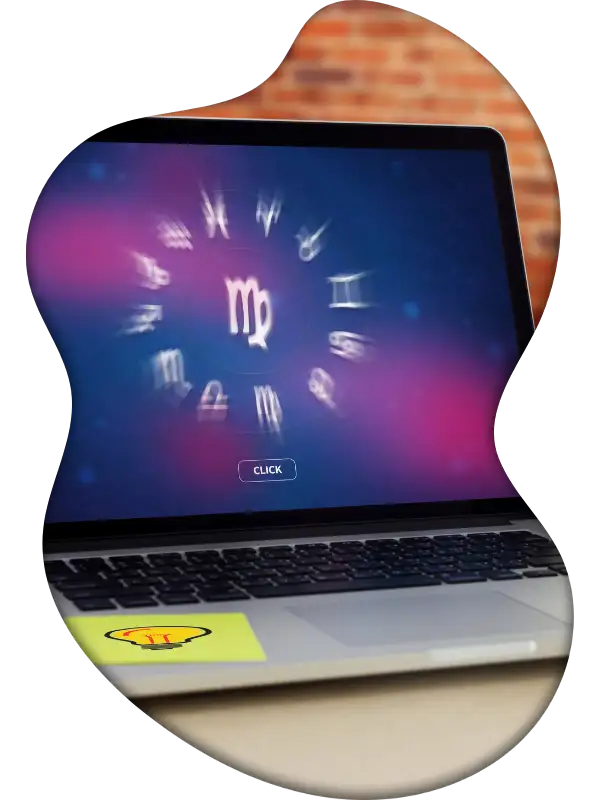In the previous article on aspects, you learned what aspects are in astrology. Now it's time to understand the effects of planetary aspects.
[toc]
The Strength of Close Aspects
When the zodiacal circle refracts the rays of a planet, focusing it on miniature “copies,” these “copies” vary in size. The most significant reflection of the planet is at the point of its opposition. Smaller copies are positioned at 120 degrees, and even smaller ones are at the places of 90 and then 60 degrees.
Morinus proposed the following scheme to assess the strength of an aspect: the stronger the aspect, the less the ray of the planet approaching the Earth deviates from its course. Interestingly, it reminds the real interference picture of the ray discovered long after Morinus.
Suppose the light of a planet penetrates the Earth and creates a “copy” of the planet at the opposite point of the zodiac. The ray doesn’t deviate from its course and reaches the place of opposition with no dissipation. Let’s assume 180 degrees (the line from the planet to the point of its opposition) as 100% of the aspect’s strength. Any other aspects lose strength as they deviate from this straight line.
For example, 90 degrees is half of 180 degrees. So the zodiac circle focuses the ray of the planet at $\pm$90 degrees twice less effectively than in the place of opposition. We can call this “the strength of the square is half the strength of the opposition.”
By the same logic, a trine is 2/3 of the strength of the opposition, and a sextile is 1/3 of it.
Thus, we can express the strength of aspects as follows:
- Conjunction, opposition—1
- Trine—2/3
- Square—1/2
- Sextile—1/3
These values can be useful when we want to understand the overall impact of mixed influences. For example, my business is experiencing the influence of various factors.
- Brutal competitors exert pressure by the square aspect.
- On the other hand, my business is connected to the noble significator of the government, which legislatively supports my side.
The overall impact on the business is positive since the conjunction prevails over the square. The government protects my business.
Another example.
- Merciless competitors are pressuring my business by close opposition.
- The noble significator of the government supports my business by sextile.
The overall impact is destructive—the government doesn’t significantly hinder my competitors who actively disrupt the operation of my outlets. Opposition prevails over
Do not apply the strength of aspects when you consider just one aspect. Suppose my business is under pressure from competitors, and nothing else supports it. The business significator receives only one adverse aspect—the aspect from competitors. In that case, the square aspect does not make this pressure less intense than the pressure by the opposition. It is just the pressure, and it is still destructive “per se.”
We only use the strength of aspects when comparing multiple aspects that the significator receives from other planets.
The Effect of Aspect in Connection With Its Form
Often, a planet has both strengths and weaknesses simultaneously. For instance, the Moon may be in its triplicity and at the same time in detriment. Or, it may happen that Venus, while in its triplicity, has an evil ruler, giving Venus some negative traits.
This “duality” is crucial for aspects. The zodiacal circle puts either a debilitated or dignified part of the planet in the place of its aspect.
You can think of it this way:
- Favorable aspects smoothly conduct all the good/neutral sides of the planet and mostly dissipate all the bad it carries.
- Unfavorable aspects smoothly conduct all the bad/neutral sides of the planet and significantly dissipate its good attributes.
Trine and sextile are favorable aspects, while opposition and square are malevolent.
Let’s consider some examples:
Example 1
Let’s assume Mars is in the place of its triplicity and detriment. If Mars signifies medicines, we would say that medicines generally have a negative effect. However, they partially help to support mental activity.
Now, consider the square of Mars. All the good in those medicines almost disappeared in the degree of square aspect. And all the adverse effects of Mars remain. Such a “copy” of Mars would be destructive.
Now, consider the trine of Mars. Support for mental activity remains unchanged. And all the side effects from the medicines vanish. The “copy” of Mars in the place of its trine becomes constructive.
Example 2.
Now, imagine a person signified by Venus in exile. It’s better not to encounter such a person on the street. But the ruler of this Venus is a noble planet. This person came into the house of an aristocrat and was forced to behave accordingly. It doesn’t make the person noble but gives him some manners.
Moreover, the person is surrounded by two noble planets, making his behavior even more refined. It is as if two mentors accompany this person, guiding him on etiquette rules at every opportunity. Of course, this doesn’t change the person’s nature, but it gives them enough manners not to behave like a gentleman.
Aspects will change the picture:
- The opposition of this Venus washes away all the nobility, returning Venus to a state of pure exile.
- The sextile of the same Venus essentially dissolves the evil nature of Venus, leaving all the acquired manners untouched.
The Effect of the Aspect in Connection with the Place It Falls
Let’s move further in our discussions. Since an aspect is a miniature copy of a planet, we need to consider the essential condition of this copy.
It may happen that the “copy” falls into a sign of incompatible nature and ends up in exile. Alternatively, it may fall into its domicile and acquire nobility. We should consider that. Let’s look at examples.
Suppose Mars is at 15 Cancer—in its fall and triplicity. It represents medicine that mainly harms but partially helps.
Now, consider the trine of Mars. In this position, the “copy” of Mars is like Mars in triplicity, almost devoid of defects. This medicine moderately helps with scarcely noticeable side effects.
Let’s consider the places where trigon falls:
- Dexter trine of Mars at 15 Pisces. Here, the “copy” of Mars landed in its triplicity, meaning the medicine now provides even more noticeable assistance.
- Sinister trine of Mars at 15 Scorpio. The aspect of Mars has landed in its domicile—the medicine now carries a healing effect. Any side effects are almost invisible against the positive impact.
Now, let’s consider the opposition of Mars. The opposition retains these medicines’ negative aspects, dissipating the positive effects. The “copy” of Mars in the place of opposition is similar to Mars in its fall without the signs of triplicity.
Now, let’s consider the sign of the opposition. The aspect falls into the sign of Capricorn—the place of Mars’ exaltation. It compensates for the debility of Mars’ “copy,” causing the effect of the medicine to be useless.
Now, let’s look at the square of Mars. Like the opposition, it corresponds to Mars in its fall without signs of triplicity. But the final effect of the square will be different.
- Dexter square falls into 15 Aries, the place of Mars’ rulership. Considering that dignity by rulership prevails over debility by fall, the “copy” of Mars has acquired some minor positive attributes. The medicine in 15 Aries has a moderately favorable impact. But since a miniature copy of Mars causes this moderate impact, it is still less than the original positive effect from Mars in triplicity.
- Sinister square falls into 15 Libra—the place of Mars’ exile. It makes the falling copy of Mars even more evil. In 5 Libra, the medicine imposes maximum harm to the body.
It’s important to understand that in our example, for the medicine to impact the querent, the querent’s planet must be close to Mars’ aspect within its orb.
Let’s summarize the impacts of these aspects.
- The initial effects of medicines are mainly harmful, though they help.
- Trine: medicines help/heal with no side effects
- Quadrature: the medicines are more harmful/less effective
- Opposition: the medicines are useless
As you see, the favorable aspects make the planet more effective, while the unfavorable aspects diminish the planet’s effectiveness.
The Cumulative Effect of Close Aspect and Reception
We have studied in detail how the aspect of one planet impacts the other planet. However, we have not considered receptions that may exist between two significators.
As you already know, a planet in a sign always subordinates to its dispositor. We consider this subordination when the dispositor plays a crucial role in the question.
For example, suppose Venus represents the employee, and Saturn represents the company. Venus in Libra (in Saturn’s exaltation) indicates a qualified employee dedicated to the company. This dedication to the job applies to Venus and all its aspects, including the opposition.
The opposition of Venus in Aries is destructive. The “evil copy” of Venus in the employee’s 5th house may represent his newborn baby, causing him to lose sleep at night and be late for work.
But since there is a positive reception between the employee and the job, the employee does everything to mitigate the situation—he works overtime.
Therefore, reception modifies the action of the aspect for better or for worse according to the context.


